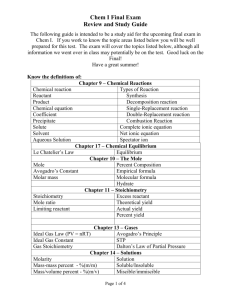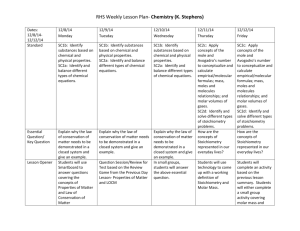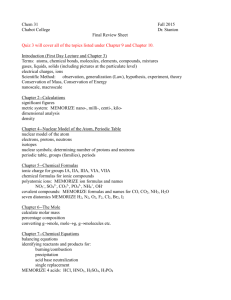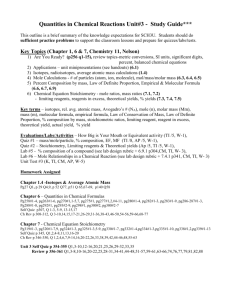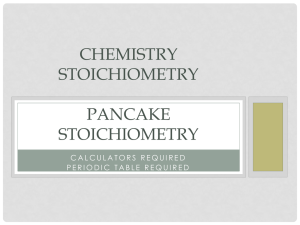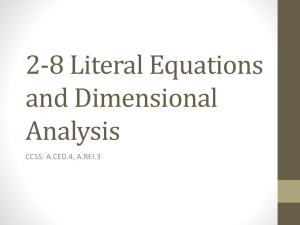Guided Notes
advertisement
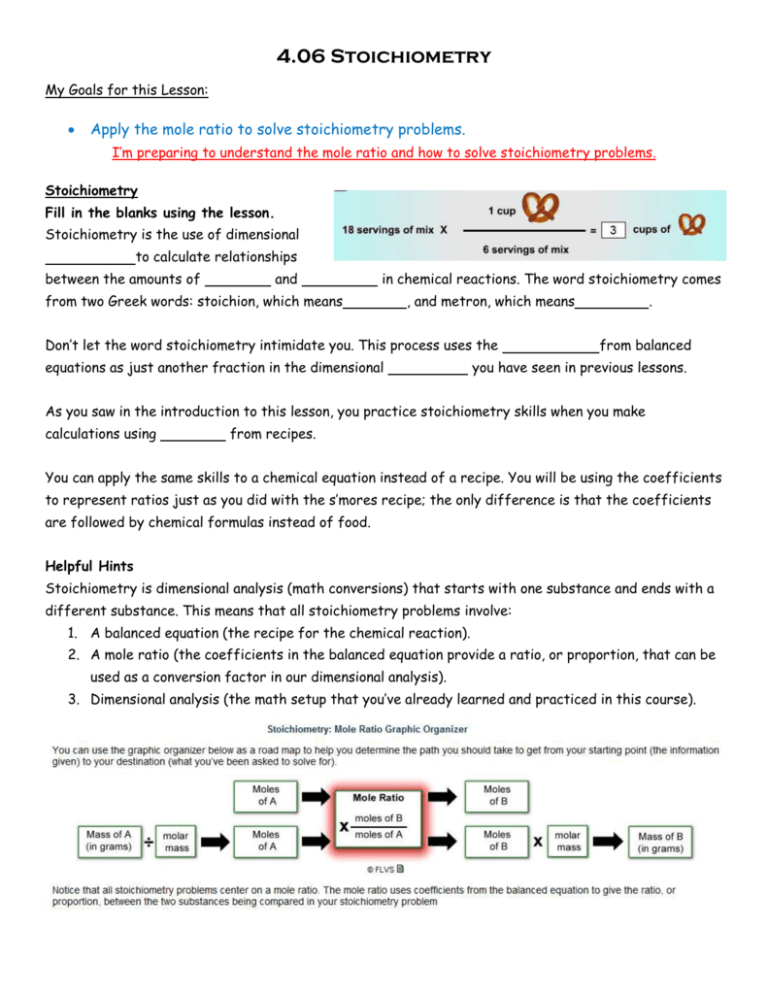
4.06 Stoichiometry My Goals for this Lesson: Apply the mole ratio to solve stoichiometry problems. I’m preparing to understand the mole ratio and how to solve stoichiometry problems. Stoichiometry Fill in the blanks using the lesson. Stoichiometry is the use of dimensional to calculate relationships between the amounts of and in chemical reactions. The word stoichiometry comes from two Greek words: stoichion, which means , and metron, which means Don’t let the word stoichiometry intimidate you. This process uses the equations as just another fraction in the dimensional . from balanced you have seen in previous lessons. As you saw in the introduction to this lesson, you practice stoichiometry skills when you make calculations using from recipes. You can apply the same skills to a chemical equation instead of a recipe. You will be using the coefficients to represent ratios just as you did with the s’mores recipe; the only difference is that the coefficients are followed by chemical formulas instead of food. Helpful Hints Stoichiometry is dimensional analysis (math conversions) that starts with one substance and ends with a different substance. This means that all stoichiometry problems involve: 1. A balanced equation (the recipe for the chemical reaction). 2. A mole ratio (the coefficients in the balanced equation provide a ratio, or proportion, that can be used as a conversion factor in our dimensional analysis). 3. Dimensional analysis (the math setup that you’ve already learned and practiced in this course). Steps to Solve Fill in the blanks using the lesson. Steps for solving a basic stoichiometry problem: 1. Write a balanced chemical equation. (You need the coefficients for the mole ratio.) 2. Identify the given information and what you have been asked to solve for in the question. 3. Starting with the given information (measurement and unit), set up the dimensional analysis problem. Use the units as a guide, and remember that a mole ratio is the only way to convert from one substance to another in a calculation. 4. Solve the dimensional analysis calculation by multiplying everything in the numerators and dividing by everything in the denominators. Remember to check your setup by making sure that all the units cancel except the unit for your final answer. Complete each example step by step using the tabs in the lesson as a guide. Example One: How many moles of hydrogen gas (H2) would be needed to form 8.6 moles of ammonia (NH3)? N2 + H2 → NH3 1) The first thing you need to always make sure you do is balance the chemical equation. An equation needs to be balanced so that you can use correct coefficients in your ratios. Balance the equation below. 2) Next, look at the question you are being asked to solve. The question usually includes a given amount of one substance as well as the unit of another substance you are being asked to solve for. Once you have identified both pieces of information, you have identified the starting point and the destination of your calculation. In this question, what is the given measurement? What are you being asked to solve for in this question? 3) Always start your dimensional analysis problem with the amount given in the word problem. Then, use the units to help you determine the path you will take to reach your destination. Because the given information is already in moles, you are ready to use the mole ratio as the next step. Use the coefficients from the balanced equation as the mole ratio to convert from moles of one substance to moles of another substance. Set up the problem below. Show all the work, steps and units!! (This is required in the assessments for you to earn full credit.) Because you were asked to solve for moles of H2, the mole ratio was the only conversion factor needed for this problem. If you needed to convert from moles of H2 to grams, you would do so by adding more conversion factor steps after the mole ratio. 4) Solve the calculation by multiplying all numerators and dividing by all denominators. Do not forget to check that all of the units cancel out diagonally except for the unit of the final answer. Solve the problem below showing all the cancelations, units and have the final answer in the correct sig. figs. Example Two: How many moles of aluminum metal would be needed to produce 35.6 grams of aluminum oxide in the following synthesis reaction? Al + O2 → Al2O3 1) Balance the chemical equation. 2) Identify the given amount as well as what you are being asked to solve for in the question. Given: Asked for: 3) Start your dimensional analysis problem with the amount given in the word problem and use the units to help you determine the path you will take to reach your destination. Remember to use the periodic table to help you determine the molar mass of elements and compounds. Determined the molar mass of aluminum oxide below. Set up the dimensional analysis calculation below. Show all the work, steps and units!! (This is required in the assessments for you to earn full credit.) 4) Solve the calculation, being sure to check that all of the units cancel except the unit of the final answer. Example Three: How many grams of sodium metal are needed to react completely with 45.6 grams of water? Na + H2O → NaOH + H2 1) Write out the balanced equation for the reaction. 2) Identify the given information and what you have been asked to solve for from the word problem. Given: Asked for: 3) Set up your dimensional analysis calculation, starting with the measurement given in the problem. Determined the molar mass of water below. Set up the dimensional analysis calculation below. Show all the work, steps and units!! (This is required in the assessments for you to earn full credit.) 4) Solve the calculation, checking your set up by making sure all units cancel except the unit for your final answer. Be sure to do the Let’s Practice and print the practice sheet on the Activity page of the lesson.
